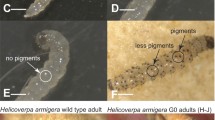Abstract
The conversion of pyruvoyl-H4-pterin to pyrimidodiazepine (PDA), which is an essential step in the biosynthesis of the red components of Drosophila eye pigments known as drosopterins, requires the products of the genes sepia and clot. While the product of sepia has been shown to correspond to the enzyme PDA-synthase, the role of clot remains unknown, although the clot 1 allele was one of the first eye-color mutants to be isolated in Drosophila melanogaster, and much genetic and biochemical data has become available since. Here we report the cloning of the clot gene, describe its molecular organization and characterize the sequence alterations associated with the alleles cl 1 and cl 2. The coding properties of the gene show that it encodes a protein related to the Glutaredoxin class of the Thioredoxin-like enzyme superfamily, conserved members of which are found in human, mouse and plants. We suggest that the Clot protein is an essential component of a glutathione redox system required for the final step in the biosynthetic pathway for drosopterins.




Similar content being viewed by others
References
Adams MD, et al (2000) The genome sequence of Drosophila melanogaster. Science 287:2185–2195
Ashburner M (1989) Drosophila: a laboratory manual. Cold Spring Harbor Laboratory Press, Cold Spring Harbor, N.Y.
Ashburner M, Richards G, Velissariou V (1980a) New and revised cytological locations of miscellaneous mutations. Drosophila Inf Serv 55:196
Ashburner M, Faithfull J, Littlewood T, Richards G, Smith S, Velissariou V (1980b) Report on new mutants: Drosophila melanogaster. Drosophila Inf Serv 55:193–195
Bingham PM, Chapman CH (1986) Evidence that white-blood is a novel type of temperature-sensitive mutation resulting from temperature-dependent effects of a transposon insertion on formation of white transcripts. EMBO J 5:3343–3351
Brand AH, Perrimon N (1993) Targeted gene expression as a means of altering cell fates and generating dominant phenotypes. Development 118:401–415
Dalby B, Pereira AJ, Goldstein LS (1995) An inverse PCR screen for the detection of P element insertions in cloned genomic intervals in Drosophila melanogaster. Genetics 139:757–766
Dorsett D, Yim JJ, Jacobson KB (1979) Biosynthesis of "drosopterins" by an enzyme system from Drosophila melanogaster. Biochemistry 18:2596–2600
Eklund H, Ingelman M, Soderberg, BO, Uhlin T, Nordlund P, Nikkola M, Sonnerstam U, Joelson T, Petratos K (1992) Structure of oxidized bacteriophage T4 glutaredoxin (thioredoxin). Refinement of native and mutant proteins. J Mol Biol 228:596–618
Fletcher JC, Burtis KC, Hogness DS, Thummel CS (1995) The Drosophila E74 gene is required for metamorphosis and plays a role in the polytene chromosome puffing response to ecdysone. Development 121:1455–1465
Giordano E, Peluso I, Senger S, Furia M (1999) minifly, a Drosophila gene required for ribosome biogenesis. J Cell Biol 144:1123–1133
Holmgren A, Söderberg BO, Eklund H, Brändén CI (1975) Three-dimensional structure of Escherichia coli thioredoxin-S2 to 2.8 Å resolution. Proc Natl Acad Sci USA 72:2305–2309
Laski FA, Rio DC, Rubin GM (1986) Tissue specificity of Drosophila P element transposition is regulated at the level of mRNA splicing. Cell 441:7–19
Lindsley DL, Zimm GG (1992) The genome of Drosophila melanogaster.Academic Press, San Diego
Martin JL (1995) Thioredoxin: a fold for all reasons. Structure 3:245–250
Robertson HM, Preston CR, Phillis RW, Johnson-Schlitz DM, Benz WK, Engels, WR (1988) A stable genomic source of P element transposase in Drosophila melanogaster. Genetics 118:461–470
Rost B, Sander C (1993) Prediction of protein secondary structure at better than 70% accuracy. J Mol Biol 232:584–599
Rost B, Sander C (1994) Combining evolutionary information and neural networks to predict protein secondary structure. Proteins 19:55–72
Rost B, Sander C, Schneider R (1994) PHD: an automatic mail server for protein secondary structure prediction. Comp Appl Biosci 10:53–60
Rubin GM, Spradling AC (1982) Genetic transformation of Drosophila with transposable element vectors. Science 218:348–353
Sambrook J, Fritsch EF, Maniatis T (1989) Molecular aloning: a laboratory manual (2nd edn). Cold Spring Harbor Laboratory Press, Cold Spring Harbor, N.Y.
Schwinck I (1971) Epigenetic alterations of the drosopterin pattern in various mutants of Drosophila melanogaster. Genetics 68:59–60
Szidonya J, Reuter G (1988) Cytogenetic analysis of the echinoid ( ed), dumpy ( dp) and clot ( cl) region in Drosophila melanogaster. Genet Res (Camb) 51:197–208
Wiederrecht GJ, Paton RP, Brown GM (1981) The isolation and identification of an intermediate involved in the biosynthesis of drosopterin in Drosophila melanogaster. J Biol Chem 256:10399–10402
Wiederrecht GJ, Paton RP, Brown GM (1984) Enzymatic conversion of dihydroneopterin triphosphate to the pyrimidodiazepine intermediate involved in the biosynthesis of the drosopterins in Drosophila melanogaster. J Biol Chem 259:2195–2200
Acknowledgements
This work was supported by Grants from the Regione Campania (L.R. 31.12.1994 n 41) and the Consiglio Nazionale delle Ricerche (Cluster n 02 Legge 488/92) to M.F.
Author information
Authors and Affiliations
Corresponding author
Additional information
Communicated by G. Reuter
The first two authors contributed equally to this work
Rights and permissions
About this article
Cite this article
Giordano, E., Peluso, I., Rendina, R. et al. The clot gene of Drosophila melanogaster encodes a conserved member of the Thioredoxin-like protein superfamily. Mol Gen Genomics 268, 692–697 (2003). https://doi.org/10.1007/s00438-002-0792-0
Received:
Accepted:
Published:
Issue Date:
DOI: https://doi.org/10.1007/s00438-002-0792-0




